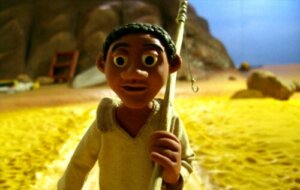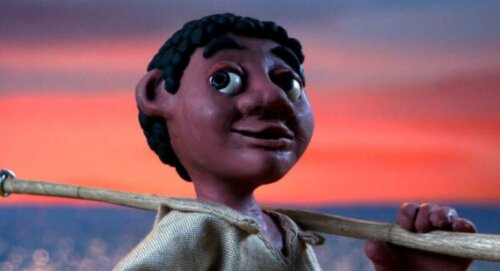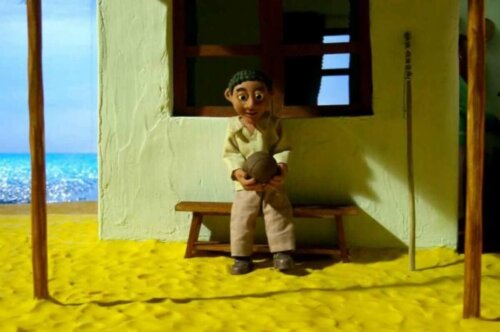Said's Journey: A Short Intercultural Education Film

Said’s journey is a heartbreaking short film with a protagonist whose story will touch your soul. Through the dreamlike and the symbolic, this short touches on current themes of a much closer reality.
It received the Goya Award for Best Animated Short Film in 2007. Set in Morocco, the story follows Said, a boy who lives with his mother by the beach. We don’t know where his father is, but we learn that he left home to achieve a better life for his family.
The story transports us to one of Said’s dreams, where he travels to the land of opportunity, in this case, Spain. However, he mistakenly reaches what seems to be a fair. Instead of finding the land of opportunity that he expected, he finds himself in an unpleasant situation, more like a nightmare. A true fair of horrors.
How to watch Said’s Journey with children and teens
The background of the film shows a more adult character, more suitable for children over 12 years of age. However, we must include intercultural content in children’s education at an early age; not only because of the personal benefits it entails, such as the possible cultural skills that children can develop, but especially because of all the positive aspects it brings on a social level. For that reason, Said’s Journey is a good film to watch.

Said’s journey offers the opportunity to address fundamental issues such as cultural awareness and differences, as well as the personal and social wealth that guarantees us interaction and coexistence with other cultures.
Also, the film offers the opportunity to teach adolescents and children about values such as empathy, respect, social responsibility, and solidarity, through different activities such as:
- Debates. After watching the film, children can summarize their impressions of Said’s Journey or discuss concepts such as discrimination, and identify real-life examples.
- Role-playing. Adolescents and children can recreate different situations; for example, by putting themselves in the shoes of a person from a different cultural group.
- Reflections from questions. They can practice critical thinking and internal reflection from a series of questions. For example: “Do you think the short film symbolizes reality?” “How would you describe the main character?” “What messages does the film convey?” “What are the values it teaches?”
- Brainstorming. They can brainstorm what actions or attitudes could be carried out, such as when dealing with stereotypes, prejudices, and discrimination toward others.

The importance of intercultural education
Our societies are increasingly diverse and multicultural, as are our classrooms. And, ultimately, education needs to adapt to the current reality. To do this, teachers must be able to respond to the different needs of their students.
In this way, intercultural education plays a fundamental role in classrooms, because we can build a fairer and more equal society where discrimination doesn’t exist.
Animated short films, such as Said’s Journey, take us to different cultural realities and help us see through another person’s eyes and understand their situation. Thanks to this type of film, we can deal with topics that are very present and close to us in the classroom, and teach students to respect and embrace cultural differences.
Said’s journey is a heartbreaking short film with a protagonist whose story will touch your soul. Through the dreamlike and the symbolic, this short touches on current themes of a much closer reality.
It received the Goya Award for Best Animated Short Film in 2007. Set in Morocco, the story follows Said, a boy who lives with his mother by the beach. We don’t know where his father is, but we learn that he left home to achieve a better life for his family.
The story transports us to one of Said’s dreams, where he travels to the land of opportunity, in this case, Spain. However, he mistakenly reaches what seems to be a fair. Instead of finding the land of opportunity that he expected, he finds himself in an unpleasant situation, more like a nightmare. A true fair of horrors.
How to watch Said’s Journey with children and teens
The background of the film shows a more adult character, more suitable for children over 12 years of age. However, we must include intercultural content in children’s education at an early age; not only because of the personal benefits it entails, such as the possible cultural skills that children can develop, but especially because of all the positive aspects it brings on a social level. For that reason, Said’s Journey is a good film to watch.

Said’s journey offers the opportunity to address fundamental issues such as cultural awareness and differences, as well as the personal and social wealth that guarantees us interaction and coexistence with other cultures.
Also, the film offers the opportunity to teach adolescents and children about values such as empathy, respect, social responsibility, and solidarity, through different activities such as:
- Debates. After watching the film, children can summarize their impressions of Said’s Journey or discuss concepts such as discrimination, and identify real-life examples.
- Role-playing. Adolescents and children can recreate different situations; for example, by putting themselves in the shoes of a person from a different cultural group.
- Reflections from questions. They can practice critical thinking and internal reflection from a series of questions. For example: “Do you think the short film symbolizes reality?” “How would you describe the main character?” “What messages does the film convey?” “What are the values it teaches?”
- Brainstorming. They can brainstorm what actions or attitudes could be carried out, such as when dealing with stereotypes, prejudices, and discrimination toward others.

The importance of intercultural education
Our societies are increasingly diverse and multicultural, as are our classrooms. And, ultimately, education needs to adapt to the current reality. To do this, teachers must be able to respond to the different needs of their students.
In this way, intercultural education plays a fundamental role in classrooms, because we can build a fairer and more equal society where discrimination doesn’t exist.
Animated short films, such as Said’s Journey, take us to different cultural realities and help us see through another person’s eyes and understand their situation. Thanks to this type of film, we can deal with topics that are very present and close to us in the classroom, and teach students to respect and embrace cultural differences.
This text is provided for informational purposes only and does not replace consultation with a professional. If in doubt, consult your specialist.








